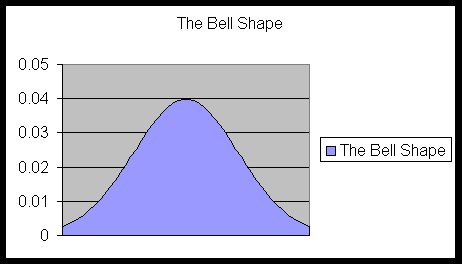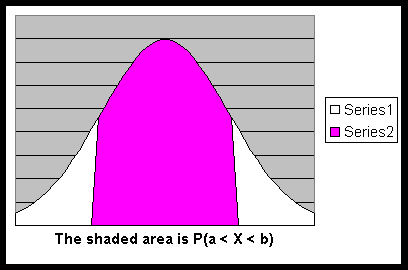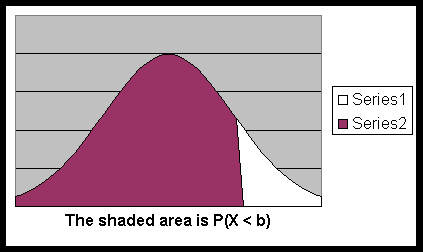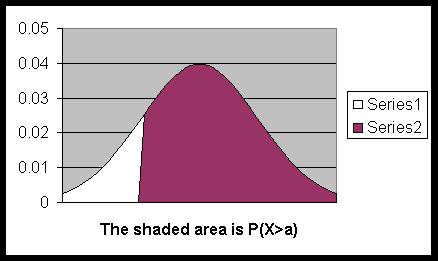
Picture 19
| Satyagopal Mandal |
| Department of Mathematics |
| Office: 624 Snow Hall Phone: 785-864-5180 |
Normal Distribution 2
We have discussed both discrete and continuous random variables. We have to note here that a normal random variable X is a continuous random variable.
For a normal random variable X, we only know 68-95-99 rule to compute probability that X is within 1, 2 or 3 standard deviation s from the mean m. We will learn how to compute the probability that X is within any two given numbers.
First, we can rephrase the definition of the normal distribution as follows:
Suppose that a random variable X (or a data set) has normal distribution with mean m and standard deviation s. Then the relative frequency histogram of the data has a perfect bell shape as follows.
 Picture 19 |
Now we have the following:
P(a < X < b) = P(a < X < b ) =
P(a < X < b) = P(a < X < b) =
the area under the normal curve, above the x-axis and between the vertical lines x = a and x = b.
 Picture 20 |
Remark: Note that this formula says the probability that X is between a or b. The formula does not care if we include one or both a and b or not.
P( X < b) = P( X <b) =
the area under the normal curve, above the x-axis and on the left side of the vertical line x = b.
 Picture 21 |
and
P(a < X) = P(a < X) =
the area under the normal curve, above the x-axis and on the right side of x = a.
 Picture 22 |
The Z-Table
(The z-table is also available separately.)
The Z-Table
Recall that the normal random variable with mean zero and standard deviation one is called standard random variable (denoted by Z) .As we have said before we will give a table for the standard normal random variable Z. The following table gives the P(Z < z) for different values of z.
 Picture 23 |
|
z |
-3.0 |
-2.9 |
-2.8 |
-2.7 |
-2.6 |
|
P(Z<z) |
0.0013 |
0.0019 |
0.0026 |
0.0035 |
0.0047 |
|
z |
-2.5 |
-2.4 |
-2.3 |
-2.2 |
-2.1 |
|
P(Z<z) |
0.0062 |
0.0082 |
0.0107 |
0.0139 |
0.0179 |
|
z |
-2.0 |
-1.9 |
-1.8 |
-1.7 |
-1.6 |
|
P(Z<z) |
0.0228 |
0.0287 |
0.0359 |
0.0446 |
0.0548 |
|
z |
-1.5 |
-1.4 |
-1.3 |
-1.2 |
-1.1 |
|
P(Z<z) |
0.0668 |
0.0808 |
0.0968 |
0.01151 |
0.1357 |
|
z |
-1.0 |
-0.9 |
-0.8 |
-0.7 |
-0.6 |
|
P(Z<z) |
0.1587 |
0.1841 |
0.2119 |
0.2420 |
0.2743 |
|
z |
-0.5 |
-0.4 |
-0.3 |
-0.2 |
-0.1 |
|
P(Z<z) |
0.3085 |
0.3446 |
0.3821 |
0.4207 |
0.4602 |
|
z |
0.0 |
0.1 |
0.2 |
0.3 |
0.4 |
|
P(Z<z) |
0.5000 |
0.5398 |
0.5793 |
0.6179 |
0.6554 |
|
z |
0.5 |
0.6 |
0.7 |
0.8 |
0.9 |
|
P(Z<z) |
0.6915 |
0.7257 |
0.7580 |
0.7881 |
0.8159 |
|
z |
1.0 |
1.1 |
1.2 |
1.3 |
1.4 |
|
P(Z<z) |
0.8413 |
0.8643 |
0.8849 |
0.9032 |
0.9192 |
|
z |
1.5 |
1.6 |
1.7 |
1.8 |
1.9 |
|
P(Z<z) |
0.9332 |
0.9452 |
0.9554 |
0.9641 |
0.9713 |
|
z |
2.0 |
2.1 |
2.2 |
2.3 |
2.4 |
|
P(Z<z) |
0.9772 |
0.9821 |
0.9861 |
0.9893 |
0.9918 |
|
z |
2.5 |
2.6 |
2.7 |
2.8 |
2.9 |
|
P(Z<z) |
0.9938 |
0.9953 |
0.9965 |
0.9974 |
0.9981 |
The Final Formula:
P(a < X < b) =
P((a-
m)/s <(X- m)/ s < (b- m)/ s) =P((a-
m)/ s < Z < (b- m)/ s) = The difference of the two numbers to be read from the z-table.
Problems on Normal Distribution
Ex. 1: The length X of life of some light bulbs produced in a factory is normally distributed with mean
m= 8640 hours and standard deviation s = 1440 hours.1) Find the probability of the event E that a bulb will last less than 5040 hours.
2) Find the probability of the event F that a bulb will last between 5040 hours and 8640 hours.
Solution 1) We have P(E) = P( X < 5040) =
P((X-
m)/s < (5040-m)/s) =P(Z < (5040-8640)/1440) =
P(Z < -2.5) = 0.0062 (This is from the table).
Solution 2) We have P(F) = P( 5040 < X < 8640) =
P((5040 -
m)/s < (X-m)/s < (8640-m)/s ) =P((5040 -
8640)/1440 < Z < (8640-8640)/1440 ) =P(-2.5 < Z < 0) =
P(Z < 0) - P(Z < -2.5) =
0.5 - 0.0062 = 0.4938.
Ex. 2: The diameter X of a bolt produced by a machine in normally distributed with a mean
m = 0.82 cm and a standard deviation s =0.004 cm. What percent of the bolts will meet the specification that they be between 0.8144 cm and 0.8268 cm in diameter.
Solution: Here we are asked to find P(0.8144 < X < 0.8268). (They want the answer in percent.) We have
P( 0.8144 < X < 0.8268) =
P((0.8144 -
m)/s < (X-m)/s < (0.8268-m)/s ) =P((0.8144 -
0.82)/0.004 < Z < (0.8268-0.82)/0.004 ) =P(-1.4 < Z < 1.7) =
P(Z < 1.7) - P(Z < -1.4) = 0.9554-0.0808 = 0.8746. So, the answer is 87.46 percent.
Ex. 3: The height X of an adult male is known to be normally distributed with mean
m = 69 inches and a standard deviation s = 2.5 inches. What percent of the adult male population is above 72 inches?
Solution: Here we are asked to find P(72 < X). (They want the answer in percent.) We have
P(72 < X) =
P((72 -
m)/s < (X-m)/s ) =P((72 -
69)/2.5 < Z ) =P(1.2 < Z) = 1 - P(Z < 1.2) =1- 0.8849 = 0.1151. So, the answer is 11.51 percent.
Ex. 4: The diameter X of a lead bolt produced by a machine has normal distribution with mean
m = 2 inches and standard deviation s = 0.05 inches. What percent of the bolts will be between 1.88 inches and 2.11 inches?
Solution: Here we are asked to find P(1.88 < X < 2.11). (They want the answer in percent.) We have
= P(1.88< X < 2.11) =
P((1.88 -
m)/s < (X-m)/s < (2.11-m)/s ) =P((1.88-2)/0.05 < Z
< (2.11-2)/0.05 ) =P(-2.4 < Z < 2.2) =
P(Z < 2.2) - P(Z < -2.4) =0.9861 - 0.0082 = 0.9779. So, the answer is 97.79 percent.
Ex. 5: Suppose the systolic blood pressure of an adult male is normally distributed with mean
m = 138 mm and standard deviation s = 10 mm. What percent of adult male population has systolic blood pressure above 157 mm?
Ex. 6: The annual expenditure X of a student is approximately normally distributed with mean
m = 11,000 dollars and standard deviation s = 1500 dollars. Approximately what percent of students spend less than 10,000 dollars?
Ex. 7: Suppose the annual production X of milk per cow is normally distributed with
m = 5500 liters and standard deviation s = 150 liters. What percent of cows have annual yield less than 5155 liters?
Ex. 8: The amount eatable oil X produced by a machine in a day is normally distributed with
m = 130 liters and standard deviation s = 25 liters. What is the probability that a machine will produce between 120 liters and 150 liters on a day?